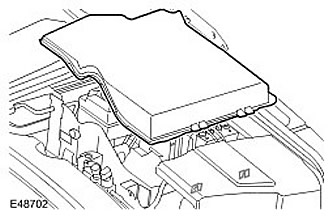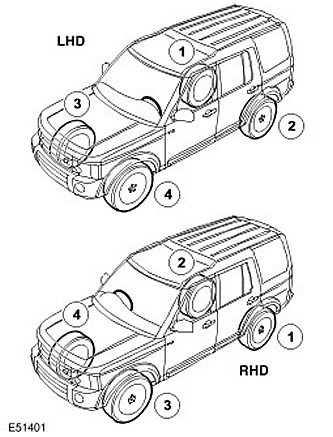CAUTION: In the event of replacing any component upstream of the hydraulic control box (HCU), including the HCU itself, the brake system MUST be bled using the appropriate T4 procedure to ensure the air is completely bled from the new part (details).
NOTE: The brake system can be bled using the appropriate T4 procedures or using the procedure below. The procedure below is for bleeding the brake system when replacing parts downstream of the HCU.
NOTE: If the performed operations affected only one of the circuits of the brake system - main or auxiliary, then only this circuit is pumped. Partial bleeding of the brake system is permitted only if there is minimal loss of brake fluid when the brake pipe or hose is disconnected.
1. WARNING: It is forbidden to carry out work on a vehicle supported only by a jack. Always place the vehicle on secure stands.
Raise and support the vehicle.
2. Make sure all brake connections are tight and there are no signs of leaks. If there are signs of brake fluid leakage, find the cause of the leak and eliminate it, and only then proceed to bleeding the brake system.
3. Press and release the brake pedal until the vacuum booster disengages.
4. Remove the manifold panel. Release 2 clips.

5.
CAUTION: Do not allow dirt or foreign liquids to enter the reservoir. Use only fresh brake fluid from a hermetically sealed container that meets specifications. It is forbidden to mix different brands of brake fluid due to their possible incompatibility.
CAUTION: Brake fluid, if it comes into contact with the paintwork, may damage it. If you spill coolant, remove it immediately and flush the area with water.
Remove the brake fluid reservoir cap. Disconnect the brake fluid reservoir electrical connector.
6. Add brake fluid to the reservoir up to the MAX mark.
7. Place a bleeder tube on the brake caliper bleeder and immerse the end of the bleeder tube in a suitable container containing a small amount of the prescribed brake fluid.
8. Start with the brake caliper furthest from the master cylinder: Loosen the bleeder screw half a turn - three quarters of a turn.

9.
CAUTION: During the entire bleed procedure, the hydraulic brake fluid reservoir must remain filled with new, clean brake fluid.
With the help of an assistant, evenly depress the brake pedal to the end and allow it to return to its original position. Repeat the procedure until clean brake fluid without bubbles begins to flow into the container.
10. When clean brake fluid without bubbles begins to flow into the container, press the pedal and do not release it.
11.
WARNING: After bleeding, do not forget to put the cap on the bleeding fitting. This will protect the bleeder fitting from corrosion.
With the brake pedal fully depressed, tighten the bleed screw (tightening torque 10 Nm).
12. Add brake fluid to the reservoir up to the MAX mark.
13.
WARNING: An incorrect sequence of bleeding the brake system can seriously affect braking performance.
Repeat the above sequence of procedures to bleed each brake caliper.
14. Add brake fluid to the reservoir up to the MAX mark.
15. Depress the brake pedal and check for leaks.
16. Install the cap on the brake fluid reservoir. Connect the brake fluid reservoir electrical connector.
17. Install the manifold panel. Fasten the clamps.
Comments on this article